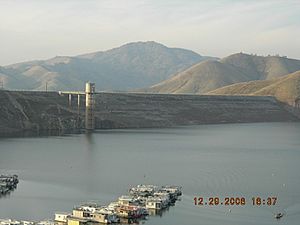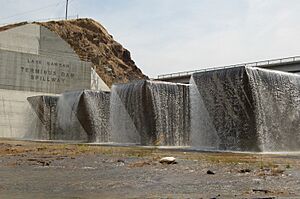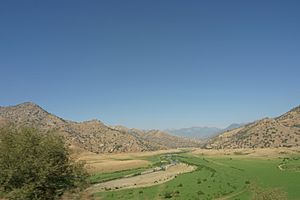Terminus Dam facts for kids
Quick facts for kids Terminus Dam |
|
|---|---|

The dam and Lake Kaweah as seen from the visitor center along Route 198
|
|
| Location | Three Rivers, Tulare County, California, United States |
| Coordinates | 36°25′01″N 119°00′14″W / 36.41694°N 119.00389°W |
| Opening date | 1962 |
| Construction cost | $24 million |
| Owner(s) | |
| Dam and spillways | |
| Type of dam | Earthfill |
| Impounds | Kaweah River |
| Height | 255 ft (78 m) |
| Length | 2,375 ft (724 m) |
| Elevation at crest | 750 ft (230 m) |
| Dam volume | 7,000,000 cu yd (5,400,000 m3) |
| Reservoir | |
| Creates | Lake Kaweah |
| Total capacity | 185,600 acre⋅ft (0.2289 km3) |
| Catchment area | 561 sq mi (1,450 km2) |
| Surface area | 1,945 acres (787 ha) |
| Power station | |
| Commission date | 1992 |
| Installed capacity | 20.09 MW |
| Annual generation | 40,894,000 KWh (2001–2012) |
| Website U.S. Army Corps of Engineers - Lake Kaweah / Terminus Dam |
|
The Terminus Dam is a large dam built on the Kaweah River in Tulare County, California, United States. It is located near Three Rivers, about 15 mi (24 km) from Sequoia National Park. The dam creates Lake Kaweah, which helps control floods and provides water for farming.
The U.S. Army Corps of Engineers (USACE) finished building the dam in 1962. Terminus Dam is an earthfill dam, meaning it is made mostly of compacted earth. It stands 255 ft (78 m) high and stretches 2,375 ft (724 m) long. Lake Kaweah can hold up to 185,600 acre⋅ft (0.2289 km3) of water, but it is usually kept at lower levels.
Contents
Building Terminus Dam: A Look Back
Terminus Dam is one of four major dams in the Tulare Lake basin. This area is at the southern end of California's San Joaquin Valley. In the 1920s, experts from the USACE and California looked for good places to build reservoirs for irrigation. After big floods in the late 1930s, the Flood Control Act of 1944 gave the USACE permission to build Terminus Dam. It was part of a plan to protect the Tulare basin from floods.
Discovering Ancient History at the Dam Site
In 1948, as plans for the dam were almost ready, a survey of the future lake area found many old Native American artifacts. These items were very important. The U.S. National Park Service's Interagency Archaeological Salvage Program carefully removed many of these artifacts. This happened before construction on the dam began.
When Was Terminus Dam Built?
Construction of Terminus Dam started in the late 1950s. It was completed in 1962. The dam was officially opened on May 18, 1962, along with the Success Dam on the Tule River. Lake Kaweah first filled up in 1964, holding 150,000 acre⋅ft (0.19 km3) of water. By 1977, a study showed that sediment had reduced this to 143,200 acre⋅ft (0.1766 km3).
Over time, Terminus Dam and the other three dams in the Tulare basin changed the area. They helped dry up Tulare Lake, which was once one of the largest wetland areas in the United States.
Upgrading the Dam: Spillway Expansion
In the 1990s, the USACE began studying how to make the dam's spillway bigger. The old spillway was not large enough to handle the biggest possible flood on the Kaweah River. Work to expand the spillway channel started in 2001. Between 2003 and 2004, six special "fusegates" were added to the spillway. These gates raised the maximum water level of the reservoir by 21 ft (6.4 m).
What are Fusegates?
The fusegates were invented by François Lempérière for Hydroplus. These are the largest fusegates in the world. They are designed to open automatically when the water in Lake Kaweah gets too high. This happens because of the water pressure. This design was chosen because it was cheaper than building a traditional concrete or gated spillway.
The spillway project increased Lake Kaweah's storage capacity by over 40,000 acre⋅ft (0.049 km3). Its current capacity is 185,600 acre⋅ft (0.2289 km3). The dam can now handle floods of up to 300,000 cu ft/s (8,500 m3/s). Before the fusegates, the dam could control a 46-year flood. Now, it can control a 70-year flood.
How Terminus Dam Helps People
The main job of Terminus Dam is to control floods. Because of this, the lake usually stays at a very low level. However, in late spring and early summer, it stores water from melting snow in the Sierra Nevada mountains. The dam protects 500,000 acres (2,000 km2) of farmland and 300,000 people along the lower Kaweah River from floods.
Soon after it was built, the dam helped during huge floods in December 1966. Terminus, Success, and Isabella Dams together prevented about $81.9 million in damages. From 1962 to 2012, Terminus Dam has prevented $373,225,000 in flood-related damages.
Providing Water for Farms and Homes
When there is no flood danger, water is released from Terminus Dam for farming. Water stored from snowmelt is released quickly between May and early August. This is when farmers need the most water for irrigation. The water goes to local water districts like the Tulare Irrigation District (TID) and Kaweah Delta Water Conservation District (KDWCD). It also supplies water to cities like Visalia and Tulare.
Generating Clean Energy
The dam also produces hydroelectricity. A power plant was built in 1992 by the Kaweah River Power Authority (KRPA). This plant is managed by TID and KDWCD. The electricity generated here is sent out by Southern California Edison. The power plant can produce 20.09 megawatts (MW) of power. This was an upgrade from its original 17 MW capacity. It generates about 40 million kilowatt hours (KWh) each year. The KRPA plans to add another 9 MW of capacity. This would allow it to generate an extra 9.2 million KWh.



